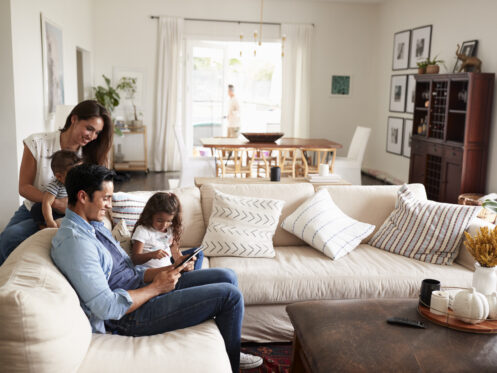Whether you’re chasing down the thermostat or piling on blankets, uneven temperatures make daily comfort harder than it should be. These temperature swings often point to airflow issues, insulation gaps, or imbalanced systems that need a closer look. At Dawson's Electric & Air, in Raleigh, NC, we help homeowners figure out what’s really causing the hot and cold spots so the fix matches the problem.
Start With Airflow Clues From Each Room
You can often feel uneven temperatures before you notice other symptoms. One room feels warm and stale, while another feels like a walk-in freezer. You might be tempted to mess with the thermostat, but that’s more of a temporary fix than a real solution. Try walking through each room instead and pay attention to the feel of the air. Does anything feel off, or is one area significantly cooler than another?
Uneven comfort can usually be traced back to airflow. Your HVAC system may be pushing air inconsistently, often due to blocked vents, poor duct layout, or a problem with the blower. If your system can’t distribute air evenly, even small issues in one area can lead to bigger comfort swings across the house. Sometimes you simply need to find a blocked return or notice a vent hidden behind furniture. Walking the house slowly can help you find the first clue.
Windows Can Throw Off the Whole System
If you’ve ruled out airflow and the temperature still shifts from one room to another, look at the windows next. Large panes of glass let in more than just sunlight. They bring in heat during the summer and let warmth leak out during colder months. Even newer windows can cause issues if they aren’t properly sealed or if the shades stay open during peak hours.
The direction your windows face makes a difference. South-facing rooms may heat up faster and stay warmer well into the evening. If your HVAC system doesn’t compensate for that heat gain, you end up with one side of the house always running warmer. Installing thermal curtains or shades can help balance the problem. Sealing gaps around the frames with weatherstripping also helps limit unwanted drafts. The goal isn’t to replace every window but to manage how each one interacts with your system. Sometimes, a small change to how you cover a window can improve the temperature across the whole floor.
Older Ductwork Can’t Always Keep Up
When your home was first built, the duct layout was designed for the appliances and energy needs of that time. Over the years, insulation shifts, materials settle, and ducts can develop tiny cracks or loose joints. Those problems build quietly.
If air has to travel through long runs of ductwork with leaks or blockages, it will lose pressure before reaching the farthest rooms. That drop creates weak airflow and uneven cooling. Upstairs bedrooms often get hit hardest. You might crank the thermostat lower, trying to cool the top floor, but that can lead to the rest of the house becoming excessively chilly. A professional duct inspection can measure the pressure drop across your system and help locate problem spots. If leaks get sealed or rerouted, the system doesn’t have to work as hard to move air evenly. You’ll feel that balance return faster than you might expect.
Furniture and Rugs Can Disrupt the System
Sometimes comfort issues aren’t about the HVAC system at all. The room layout is the problem. A vent that blows cold air might be tucked under a bookshelf or covered by a couch. When that happens, the air never has a chance to reach the full space. Instead, it pools behind furniture or beneath rugs and cannot spread evenly through the room.
This is especially common in older homes where layout changes happened after the original HVAC design. A room that used to be a dining area might now be a home office, with different needs for airflow and ventilation. You can test this by placing your hand near each vent while the system is running. If you don’t feel a steady stream, check what might be blocking the flow. Even a thick curtain can redirect cool air and make a room feel warmer than it should. Adjusting furniture placement or switching a vent cover can sometimes fix the problem in minutes.
Your Thermostat May Be In the Wrong Spot
If your home has one thermostat controlling the entire system, its placement matters more than you think. When a thermostat is in a shaded hallway or directly across from a vent, it reads a temperature that may not accurately match how the rest of the house feels. That mismatch can cause the system to turn off too early or run longer than necessary.
You might notice one room always ends up too warm, while another never seems to cool down. In some cases, the thermostat may be near a heat source like a lamp or television, which throws off the readings even more. A zoning system with multiple thermostats can help, but even relocating your main unit or installing a remote sensor can make a big difference.
Humidity Can Tip the Balance in Either Direction
When one room feels muggy while another stays dry, the difference might not be temperature alone. If moisture builds up in the air, a space can feel warmer, even when the thermostat reads the same as the rest of the house. That moisture traps heat and keeps your body from cooling down efficiently. On the other hand, overly dry air can make cooler rooms feel even colder. This swings your comfort both ways and can confuse how your system responds to set temperatures.
Bathroom fans, kitchen vents, and even laundry machines can affect humidity levels across zones in your home. If those appliances don’t vent properly, they might be dumping warm, moist air into the wrong spaces. That leads to certain rooms staying warmer or less comfortable, no matter how long your HVAC system runs. A quick check on how each space handles steam or daily moisture might help explain why one area never feels quite right.
You can smooth out the indoor climate with a whole-home humidifier or dehumidifier, but sometimes the solution isn’t about adding more equipment. It can also be about adjusting how air flows after high-moisture activities like cooking, showering, or drying clothes. Managing moisture lets your HVAC system focus on temperature instead of constantly chasing comfort tied to the air’s density. When humidity drops into a steady range across your home, rooms tend to feel more consistent, and your system doesn’t have to fight against extra variables.
Insulation Can Make or Break Temperature Control
You can’t always see what’s behind your walls and ceiling, but the insulation there helps shape the feel of each room. Inconsistent or old insulation lets conditioned air escape faster, especially in areas near the attic, garage, or crawl space. If one room always runs too cold or too warm, it might be because it shares a wall or ceiling with an uninsulated space.
Ceiling insulation plays a big role in how upstairs rooms hold cool air during the summer. If heat seeps in from the attic, the room below can struggle to stay at the right temperature, even with strong airflow. Wall insulation matters too, especially along exterior walls. You might think your HVAC system is underperforming when it’s really just fighting against poor thermal control.
Bring Balanced Temperatures Back to Your Home
Living with uneven temperatures doesn’t have to be your norm. Whether it’s insulation that needs refreshing, zoned HVAC systems, ducts that need sealing, or airflow that needs adjusting, small changes can make a big difference. In addition to airflow balancing, Dawson's Electric & Air also provides ductwork repairs and HVAC system checkups to help bring your home back into balance. You can count on our heating and cooling services!
Book your home comfort evaluation today with Dawson's Electric & Air and start feeling the difference in every room.







